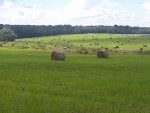Time for a research thread.
I feel the time has come to start considering a rake upgrade specific to round baling. I know nothing about these except a brief period 20 years ago when uncle and I tried out one for chopping silage. It dragged in so many rocks you could hear them go through the chopper. I know now thanks to haytalk and what I have read through the years that it was not the rakes fault.
What I want to accomplish is the ability to properly fill the round baler with ZERO weaving. JD baler w/megawide pickup. Due to my area I feel I need a center kicker to move the hay. Depending on yield we are raking 20 - 30 feet. 2-3 9ft windrows. I believe from what I have read you don't want to run a max width, that you get better results running them a certain percentage open?? I have a feeling that I would be in a big price tag to accomplish the 30' range??
What speed do they need to be ran at for optimal results?
Can they be used for baleage? We try to keep ours round 50% moisture level.
Would like to run in front of the small square baler at times. Issues? Can you utilize one side only on some models?
I'm sure will have more questions. I would be interested in brands and models past and present to look at.
Thank you in advance.
I feel the time has come to start considering a rake upgrade specific to round baling. I know nothing about these except a brief period 20 years ago when uncle and I tried out one for chopping silage. It dragged in so many rocks you could hear them go through the chopper. I know now thanks to haytalk and what I have read through the years that it was not the rakes fault.
What I want to accomplish is the ability to properly fill the round baler with ZERO weaving. JD baler w/megawide pickup. Due to my area I feel I need a center kicker to move the hay. Depending on yield we are raking 20 - 30 feet. 2-3 9ft windrows. I believe from what I have read you don't want to run a max width, that you get better results running them a certain percentage open?? I have a feeling that I would be in a big price tag to accomplish the 30' range??
What speed do they need to be ran at for optimal results?
Can they be used for baleage? We try to keep ours round 50% moisture level.
Would like to run in front of the small square baler at times. Issues? Can you utilize one side only on some models?
I'm sure will have more questions. I would be interested in brands and models past and present to look at.
Thank you in advance.







